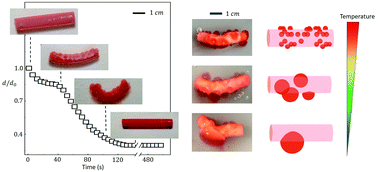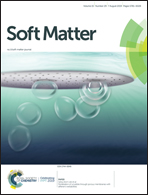On the blistering of thermo-sensitive hydrogel: the volume phase transition and mechanical instability†
Abstract
This paper explores the physical mechanisms responsible for the appearance of small blisters on the surface of temperature sensitive hydrogels as they deswell rapidly during their volume phase transition. For this, we develop a numerical model that couples the processes of hydrogel deswelling and blister growth due to the existence of a thin quasi-impermeable layer on its surface. The model points out that blister inflation originates at defects point under the gel's surface, under the effect of the increasing osmotic pressure in the gel as it undergoes its phase transition. Due to their large deformation, these blisters often experience a mechanical instability that triggers a sudden increase in their growth rate at the expense of their closest neighbors. Using a simple computational model, we then show that blisters are able to communicate via internal pressure and that these interactions are mediated by two characteristic time scales related to solvent transport within and between adjacent blisters. Our study finally indicates that these mechanisms can be controlled by temperature and the gel's cross-link density to achieve diversity of blister patterns on the gel's surface. The proposed analysis provides predictions that agree well with experimental observations of NiPAm gels which deswell in various conditions.



 Please wait while we load your content...
Please wait while we load your content...
